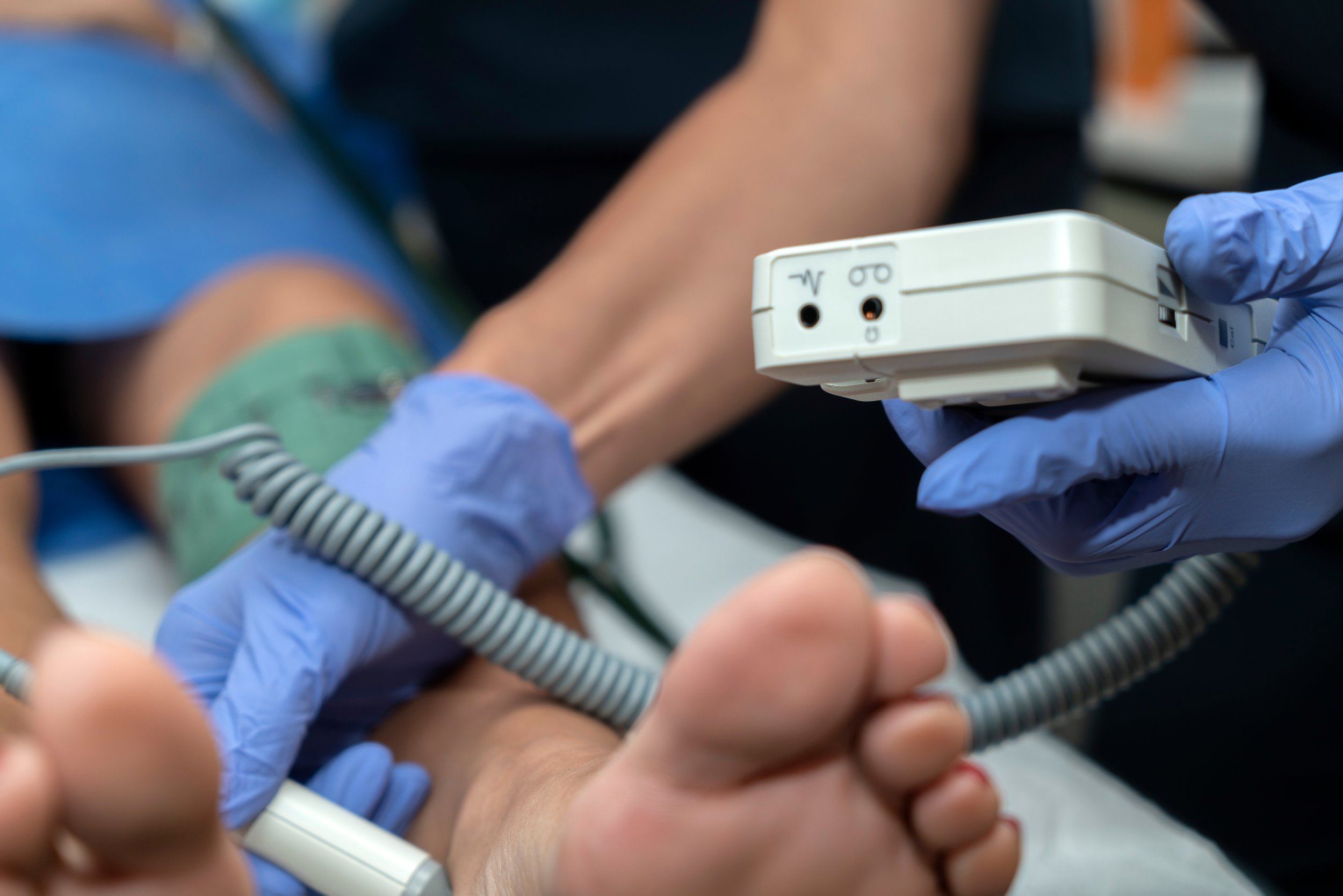Vascular Health Equity Academy Educational Resource Library
Categories
- Abdominal Aortic Aneurysm
- Aortic Dissection
- Blood Clots
- Buerger’s Disease
- Carotid Artery Disease
- Cerebrovascular Disease
- Chronic Limb-threatening Ischemia
- Congenital Vascular Malformation
- Coronary Artery Disease
- Course
- Deep Vein Thrombosis
- Diabetes
- Exercise
- Flyer
- Folletos en Español
- Health
- Healthy Habits
- Lymphedema
- Neuropathy
- Peripheral Artery Disease
- Portal Hypertension
- Prevention
- Pulmonary Embolism
- Raynaud's Disease
- Research Engagement
- Smoking Cessation
- Varicose Veins
- Venous Thromboembolism
We’re the Foundation to Advance Vascular Cures, a nonprofit organization dedicated to transforming health outcomes and well-being for all through patient-centered research, empowerment, and collaboration in vascular health. Our team of physicians, nurses, public health specialists, caregivers, and patients is excited to bring you the courses, flyers, and other resources that are part of the Vascular Health Equity Academy.
The Foundation to Advance Vascular Cures’ Patient Partners helped design and review our resources to make sure the information is focused on the patient experience. These resources are designed to help patients better understand their condition and empower them to ask questions and share concerns with their healthcare providers.
If you are a healthcare professional or community-based organization interested in distributing our educational materials, please fill out our material use request form.



Vascular Health Equity Academy: Cholesterol
Discover the role of cholesterol in your body and its impact on your health with this free educational course.


What is Peripheral Neuropathy and How is it Different from Ischemia?
Peripheral neuropathy occurs when the nerves that are outside of your brain and spinal cord are damaged. Neuropathy can happen for many reasons, but one of the most common causes is unmanaged Type II Diabetes. In some cases, neuropathy is reversible, but in others, the nerves are permanently damaged. Learn more about peripheral neuropathy in this flyer.

Patient-Led PAD Wellness Support Group
This group is a PAD patient-led group for PAD patients or their caregivers. It is meant to be a support group that shares patient experiences with implementing walking, exercise, lifestyle, and wellness support for all stages of PAD, including surgical intervention when necessary.

Full Course: Overcoming Nicotine and Tobacco Dependence for Your Vascular Health
COURSE AVAILABLE! The Foundation to Advance Vascular Cures has partnered with UCSF’s Fontana Tobacco Treatment Center to create this module called Overcoming Nicotine and Tobacco Dependence for Your Vascular Health. This 8-part module will cover several main points when it comes to quitting smoking/chewing/vaping, and provides a lot of helpful tips and exercises to guide you through your journey.

Prevention
We are dedicated to empowering patients and their loved ones with accurate and accessible information. Prevention is key to avoiding or reducing the burden that vascular disease can cause in everyday life.

A Toolkit for Patients to Engage in Research: CLTI Engagement as a Case Study
COURSE AVAILABLE! The main purpose of this toolkit is to help patients with Chronic Limb-threatening Ischemia (CLTI) learn about what it means to engage in research. The toolkit is designed to give an overview of research and research engagement. In order to provide concrete examples of how patient engagement in research really works, the toolkit profiles one type of vascular disease, Chronic Limb-threatening Ischemia (CLTI) and a case study.

A Quick Look: Overcoming Nicotine and Tobacco Dependence for your Vascular Health
COURSE AVAILABLE! The Foundation to Advance Vascular Cures has partnered with UCSF’s Fontana Tobacco Treatment Center to create this module called A Quick Look: Overcoming Nicotine and Tobacco Dependence for your Vascular Health. This module will cover several main points when it comes to quitting smoking/chewing/vaping, and provides a lot of helpful tips and exercises to guide you through your journey.

Focus on the Ankle-Brachial Index Microlearning
COURSE AVAILABLE! The ankle-brachial index (ABI) is a simple, low-cost test for diagnosing peripheral artery disease (PAD). You can get this test in a doctor’s office or lab. Learn more in this microlearning course from the Foundation to Advance Vascular Cures.

Pulmonary Embolism
Pulmonary means “lungs,” and embolism means “blockage or obstruction.” A pulmonary embolism(PE) happens when a blood clot gets trapped in an artery in the lung….

Raynaud’s Disease
Raynaud’s (ray-NOSE) disease, also known as Raynaud’s phenomenon, affects the arteries that carry blood from the heart to different parts of the body. It can cause some areas of the body to feel numb or cold in response to cold temperatures or stress. When a person has an…

Varicose Veins
Varicose veins are enlarged, bulging superficial veins. They are generally larger than 3 millimeters in diameter and are usually located on the inside of the calf or thigh. Varicose veins develop due to weakness of the vein wall…

Venous Thromboembolism (Blood Clots)
The medical term for blood clots in the veins is venous thromboembolism (thrahm-bö-EM-bö-lizm), or VTE. This describes two related conditions that are serious but…

Walking and PAD
When you walk, your leg muscles need more oxygen from blood than when sitting or standing. But if you have PAD, the arteries have a hard time delivering this extra oxygen. That’s because they’re narrowed by plaque buildup from…

What is Peripheral Artery Disease?
Peripheral artery disease (PAD) is a condition that affects millions of people. PAD occurs when there is a buildup of plaque, or fatty deposits, inside your arteries that carry blood to your legs and feet. Many people have…

Prevent Blood Clots in Your Arteries
What is the link between blood clots and Peripheral Artery Disease (PAD)? Peripheral artery disease is a common circulatory problem that occurs when your legs’ arteries (blood vessels that transport blood…

Portal Hypertension
Portal hypertension is high blood pressure in the portal vein. The portal vein is a major vein located in your abdomen that takes nutrient-rich blood from the intestines and carries it to the liver…

PAD and Smoking
Smoking is a major cause of heart disease, cancer, and lung disease and the leading cause of peripheral artery disease (PAD). Studies show that smoking half a pack of cigarettes…
Glossary
This glossary can help you better understand vascular diseases and terminology. Access the glossary to help define any words above.
Filter by Category
- Abdominal Aortic Aneurysm 1
- Aortic Dissection 2
- Blood Clots 5
- Buerger’s Disease 1
- Carotid Artery Disease 1
- Cerebrovascular Disease 1
- Chronic Limb-threatening Ischemia 5
- Congenital Vascular Malformation 1
- Coronary Artery Disease 1
- Course 10
- Deep Vein Thrombosis 2
- Diabetes 2
- Exercise 4
- Flyer 20
- Folletos en Español 9
- Health 2
- Healthy Habits 8
- Lymphedema 1
- Neuropathy 1
- Peripheral Artery Disease 15
- Portal Hypertension 1
- Prevention 1
- Pulmonary Embolism 1
- Raynaud's Disease 1
- Research Engagement 3
- Smoking Cessation 3
- Varicose Veins 1
- Venous Thromboembolism 1

